OCZ Vertex 3 (240GB) Review
by Anand Lal Shimpi on May 6, 2011 1:50 AM ESTAnandTech Storage Bench 2011 - Light Workload
Our new light workload actually has more write operations than read operations. The split is as follows: 372,630 reads and 459,709 writes. The relatively close read/write ratio does better mimic a typical light workload (although even lighter workloads would be far more read centric).
The I/O breakdown is similar to the heavy workload at small IOs, however you'll notice that there are far fewer large IO transfers:
| AnandTech Storage Bench 2011 - Light Workload IO Breakdown | ||||
| IO Size | % of Total | |||
| 4KB | 27% | |||
| 16KB | 8% | |||
| 32KB | 6% | |||
| 64KB | 5% | |||
Despite the reduction in large IOs, over 60% of all operations are perfectly sequential. Average queue depth is a lighter 2.2029 IOs.
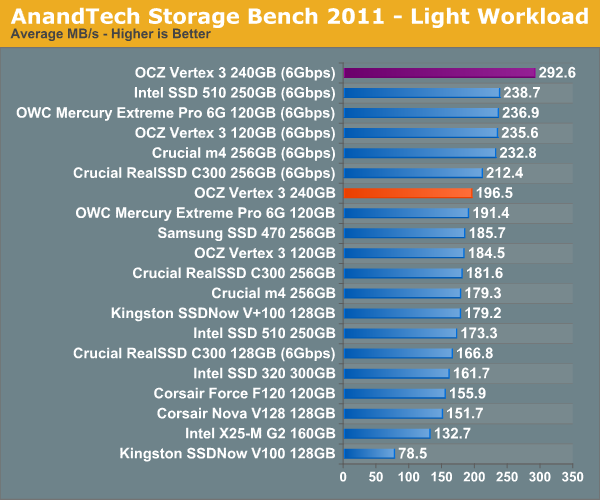
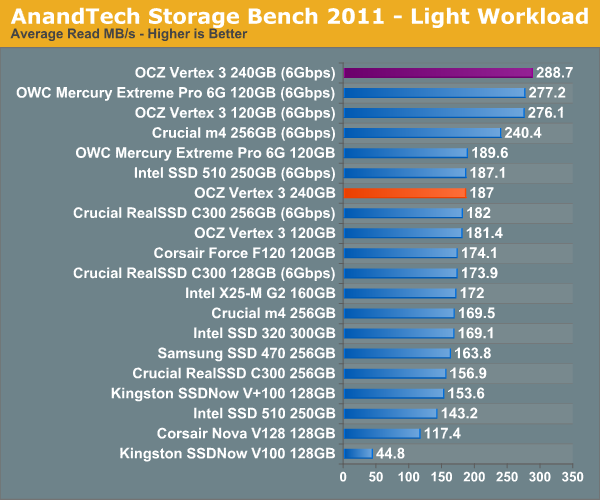
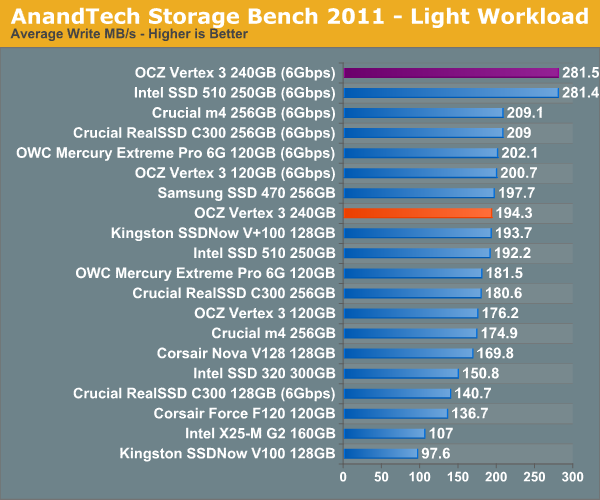
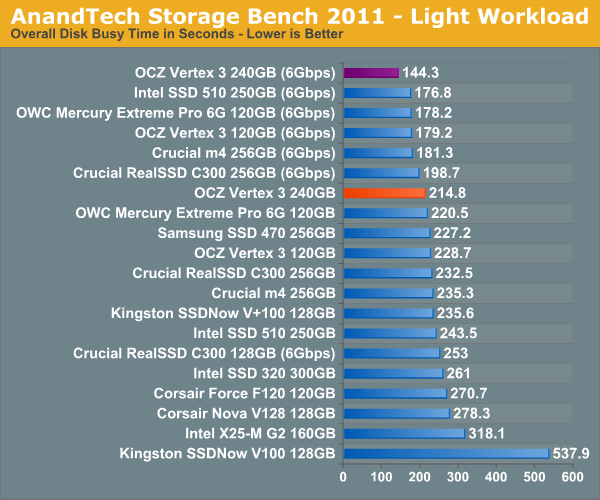
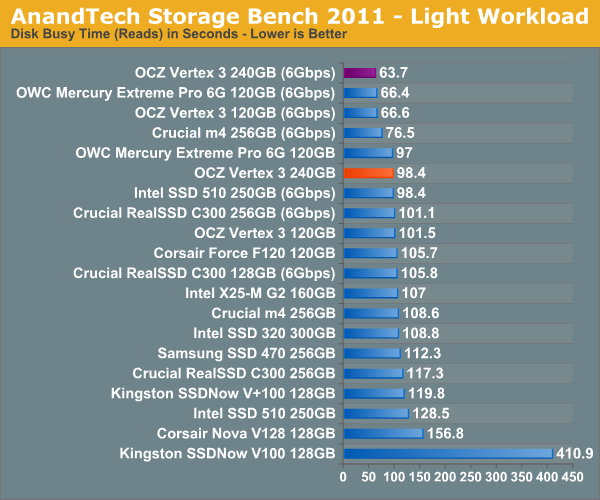











90 Comments
View All Comments
dagamer34 - Friday, May 6, 2011 - link
Great review Anand, but a far more practical question is this, why should the average consumer get the OCZ Vertex 3 at a almost $100 street price premium when the Vertex 2 performs reasonably well in all areas that matter? Almost no regular consumer is actually going to benefit from having sustained 500MB/sec read/writes compared to 200MB/sec because you'd actually need a source/destination that can also dish out or take in data that fast. Sure, compared to a HDD, any SSD is better, but is for example loading Windows in 14 seconds as opposed to 9 seconds really worth that much.Of course, for business markets, all bets are off and faster is almost always better since they've got RAID arrays churning to get data access as fast as possible. One SSD can easily replace a RAID 5 Raptor array at a far lower cost.
Anand Lal Shimpi - Friday, May 6, 2011 - link
I think for the average consumer simply making the move to an SSD is good enough. From there it's a question of subtlety. I can notice the difference on a Sandy Bridge system between a Vertex 2 and Vertex 3 - is it worth the price premium? For most users I'd say no, particularly if you aren't running a platform with a good 6Gbps controller.Take care,
Anand
aegisofrime - Friday, May 6, 2011 - link
Thanks for the answer, I was wondering the same thing as well. With Vertex 2s going for cheap nowadays, I think I can settle for a Vertex 2. Thanks for all the great work Anand, Anandtech is the first site I hit when I wake up :)vol7ron - Friday, May 6, 2011 - link
It's good advice, but also keep in mind scalability and future-proofing.How long do you keep your HDs? I keep mine until failure. Even if I don't have enough SATA ports on my mobo/cards, I'll use USB transformers to make user of the drives.
How important is it to you to buy an inferior product? To most users, it might not matter and the others might not care; but keep in mind you might use it as an external drive some day and you might want it to be able to saturate, or at least make use of the bandwidth for that external interface - think USB3/4 or Light Peak (Thunderbolt).
That being said, "deals" are deals for a reason and there's no such thing as a bad deal, just "mistakes" and "favors."
Rasterman - Monday, May 9, 2011 - link
That doesn't make any sense, drives can last for 10 years or more, are you really telling me you have a 50MB drive from 10 years ago that you have hooked up to a USB port sucking 10-20W down? At some point it makes more sense to consolidate and upgrade, its only a matter of time before the cost to simply power the drive isn't worth the money. Add to that error rates increase exponentially as the drive ages and your data will simply not be reliable.I personally get a new storage drive every 3-4 years, the old ones are re-purposed into encrypted off-site backups as they usually aren't worth anything used.
jharmon - Friday, May 6, 2011 - link
Again Anand, thank you so much for an excellent review. However, I was wondering if you could expound a bit more on this comment. I am currently running the X58 with Marvell 9128 controller. It is a sata 6Gbps interfaces, but the max bandwidth on that is 500 MB/s and it seems to be capping performance. Even OCZ warns about this on their website.You say you notice a different on SandyBrige, but what about the X58 platform?
Thanks again!
vol7ron - Friday, May 6, 2011 - link
These kinds of questions should go to the forum. Though authors/owners, do respond to some comments, the "Comments" section is not for questions, especially questions of another technology. I think they are meant for readers and users to leave comments on the article, content, or food-for-thought.v8x - Monday, May 9, 2011 - link
I do not agree, Who are you to decide what goes into the forums and what not? If Anand makes a statement in an article he wrote, it's not more than natural that questions on that statement go in the comments section.It is not a question on another technology, it's a question on a statement Anand made.
Hargak - Friday, May 6, 2011 - link
Actually, your RAM is usually the secondary device in 99% of the situations. And your RAM can receive data much faster than transferring it to another Vertex 3. Hence the improvements in loading large programs such as photoshop or big gaming programs. Whenever it is loading something you are taking data from the hard drive and caching it to RAM so the CPU can work with it in a much lower latency higher bandwidth situation. Then again, the question is whether or not the data is compressable. If it isn't then your basically back to Vertex 2 speeds. I'm also assuming in RAID 0 situations you would have a large margin of read bandwidth depending on the type of data compressable or uncompressable. I've been sold on SSD's since I found out that I could actually overclock the drive. I suggested to one of the engineers (Tony) hat they sell an overclocked version since there is headroom in added frequency. I overclocked the southbridge which made ~10% increase in performance on an old Core SSD. Down the road we may see performance SSD's possibly in card format with heatsinks and fans on them.Hargak - Friday, May 6, 2011 - link
Forgot to mention, that's how they came up with the Vertex Turbo, ;)